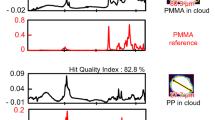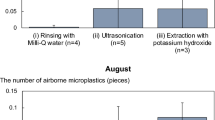Abstract
Indoor and outdoor concentrations of atmospheric gaseous pollutants as well as composition, size, and morphology of particulate matter have been investigated at the monastery of San Jerónimo in Granada (Southern Spain). Complementary micro- and nano-analytical techniques were applied; elemental and mineralogical composition and morphological characteristics of particulate matter were investigated combining electron probe microanalysis at the single particle level, and bulk aerosol samples were analyzed using energy-dispersive X-ray fluorescence, X-ray diffraction, scanning electron microscopy with energy-dispersive X-ray analyzer and transmission electron microscopy (TEM). Microclimatic conditions at the monastery were monitored, and gas concentrations were assessed by means of diffusion tubes subsequently analyzed with ion chromatography. Results revealed high abundances of soil dust particles (aluminosilicates, calcite, dolomite, quartz), salt aerosols (chlorides, sulfates and ammonium-rich salts), and NO2 and SO2 both outdoors and indoors. Amorphous black carbon particles had surprisingly high abundances for Granada, a non-industrialized city. The composition of indoor particles corresponds to severe weathering affecting the construction materials and artworks inside the church; moreover their composition promotes a feedback process that intensifies the deterioration. Chemical reactions between chloride-rich salts and pigments from paintings were confirmed by TEM analyses. Indoors, blackening of surface decorative materials is fostered by particle re-suspension due to cleaning habits in the monastery (i.e. dusting). This is the first air quality study performed in a monument in the city of Granada with the aim of developing a strategy for preventive conservation.









Similar content being viewed by others
References
Bonazza A, Sabbioni C, Ghedini N (2005) Quantitative data on carbon fractions in interpretation of black crusts and soiling on European built heritage. Atmos Environ 39:2607–2618
Bondarenko I, Treiger B, Van Grieken R, Van Espen P (1996) IDAS: a Windows based software package for cluster analysis. Spectrochim Acta B51:441–456
Brimblecombe P, Thickett D, Hun Yoon Y (2009) The cementation of coarse dust to indoor surfaces. J Cult Herit 10:410–414
Camuffo D, Bernardi A, Sturaro G, Valentino A (2002) The microclimate inside the Pollaiolo and Botticelli rooms in the Uffizi Gallery, Florence. J Cult Herit 3:155–161
Cardell C (1998) Salt crystallization in calcarenites: application to the Monastery of Saint Jerome, Granada (Spain). Dissertation, University of Granada (in Spanish)
Cardell C, Rodríguez-Gordillo J (2003) Polychromes in the Church of the Monastery of San Jerónimo in Granada: composition, alteration and applied techniques. Bol Soc Esp Mineral 26:113–121 (in Spanish)
Cataldo R, De Donno A, De Nunzio G, Leucci G, Nuzzo L, Siviero S (2005) Integrated methods for analysis of deterioration of cultural heritage: the Crypt of “Cattedrale di Otranto”. J Cult Herit 6:29–38
Corgnati SP, Fabi V, Filippi M (2009) A methodology for microclimatic quality evaluation in museums: application to a temporary exhibit. Build Environ 44:1253–1260
De Hoog J, Osán J, Szalóki I, Eyckmans K, Worobiec A, Ro C-U, Van Grieken R (2005) Thin-window electron probe X-ray microanalysis of individual atmospheric particles above the North Sea. Atmos Environ 39:3231–3242
Delalieux F, Cardell C, Todorov V, Dekov V, Van Grieken R (2001) Environmental conditions controlling the chemical weathering of the Madara Horseman monument, NE Bulgaria. J Cult Herit 2:43–54
Díaz-Hernández JL, Párraga J (2008) The nature and tropospheric formation of iberulites: pinkish mineral microspherulites. Geochim Cosmochim Acta 72:3883–3906
Esbert RM, Díaz-Pache F, Grossi CM, Alonso FJ, Ordaz J (2001) Airborne particulate matter around the Cathedral of Burgos (Castilla y Leon. Spain). Atmos Environ 35:441–452
García-Diego FJ, Zarzo M (2010) Microclimate monitoring by multivariate statistical control: the renaissance frescoes of the Cathedral of Valencia (Spain). J Cult Herit. doi:10.1016/j.culher.2009.06.002
Gysels K, Delalieux F, Deutsch F, Van Grieken R, Camuffo D, Bernardi A, Sturaro G, Busse HJ, Wieser M (2004) Indoor environment and conservation in the Royal Museum of Fine Arts, Antwerp, Belgium. J Cult Herit 5:221–230
Ivleva NP, McKeon U, Niessner R, Pöschl U (2007) Raman microspectroscopic analysis of size-resolved atmospheric aerosol particle samples collected with an ELPI: soot, humic-like substances, and inorganic compounds. Aerosol Sci Technol 41:655–671
Jordan MM, Sanfeliu T, Gómez ET, Pallarés S, Vicente AB (2009) A valuation of the influence of particulate atmospheric aerosol in constructions of the cultural and architecture patrimony of the urban area of Castellon (NE, Spain). Water Air Soil Pollut 200:245–251
Kontozova-Deutsch V (2007) Characterisation of indoor gaseous and particulate pollutants for conservation in museums and churches. Dissertation, University of Antwerp
Kontozova-Deutsch V, Deutsch F, Godoi RHM, Spolnik Z, Wei W, Van Grieken R (2008a) Application of EPMA and XRF for the investigation of particulate pollutants in the field of cultural heritage. Microchim Acta 161:465–469
Kontozova-Deutsch V, Godoi RHM, Worobiec A, Spolnik Z, Krata A, Deutsch F, Van Grieken R (2008b) Investigation of gaseous and particulate air pollutants at the Basilica Saint-Urbain in Troyes, related to the preservation of the medieval stained glasses windows. Microchim Acta 162:425–432
La Gennusa M, Rizzo G, Scaccianoce G, Nicoletti F (2005) Control of indoor environments in heritage buildings: experimental measurements in an old Italian museum and proposal of a methodology. J Cult Herit 6:147–155
Laiz L, Cardell C, Rodríguez-Gordillo JF, Saiz-Jiménez C (2000) Bacteria in the efflorescences of Saint Jerome church, Granada, Spain. In: 5th international symposium on the “The Conservation of Monuments in the Mediterranean Basin”, Seville, Spain, 15–16
Liu X, Zhu J, Van Espen P, Adams F, Xiao R, Dong S, Li Y (2005) Single particle characterization of spring and summer aerosols in Beijing: formation of composite sulfate of calcium and potassium. Atmos Environ 39:6909–6918
Lyamani H, Olmo FJ, Alados-Arboledas L (2010) Physical and optical properties of aerosols over an urban location in Spain: seasonal and diurnal variability. Atmos Chem Phys 10:239–254
Martín-Ramos JD (2004) Using XPowder: a software package for powder X-ray diffraction analysis. http://www.xpowder.com. D.L.; 2004. GR 1001/04, ISBN 84-609-1497-6
Massart D, Kaufmann L (1983) The interpretation of analytical chemical data by the use of cluster analysis. Wiley, New York
Moropoulou A, Bisbikou K, Van Grieken R, Torfs K, Polikreti K (2001) Correlation between aerosols, deposits and weathering crusts on ancient marbles. Environ Technol 22:607–618
Murr LE, Bang JJ (2003) Electron microscope comparisons of fine and ultra-fine carbonaceous and non-carbonaceous, airborne particulates. Atmos Environ 37:4795–4806
Nazaroff WW, Ligocki MP, Salmon LG, Cass GR, Fall T, Jones MC, Liu HIH, Ma T (1993) Airborne particles in museums, research in conservation. The Getty Conservation Institute, USA
Pérez-Rodríguez L, Maqueda C, Jiménez de Haro MC, Rodríguez-Rubio P (1998) Effect of pollution on polychromed ceramic statues. Atmos Environ 32:993–998
Puga E, Díaz de Federico A, Nieto JM, Díaz Puga MA (2007) Petrology, geodynamic evolution and georesources of the Natural Space of Sierra Nevada. Est Geol 63:19–40 (in Spanish)
Ro CU, Oh K-Y, Kim H, Kim YP, Lee CB, Kim K-H, Kang CH, Osán J, de Hoog J, Worobiec A, Van Grieken R (2001) Single-particle analysis of aerosols at Cheju Island, Korea, using low-Z electron probe X-ray microanalysis: a direct proof of nitrate formation from sea salts. Environ Sci Technol 35:4487–4494
Ro CU, Osan J, Szaloki I, de Hoog J, Worobiec A, Van Grieken R (2003) A Monte Carlo program for quantitative electron-induced X-ray analysis of individual particles. Anal Chem 75:851–859
Rodríguez-Gordillo J, Sáez-Pérez MP (2006) Effects of thermal changes on Macael marble: experimental study. Constr Build Mater 20:355–365
Rodriguez-Navarro C, Sebastian E (1996) Role of particulate matter from vehicle exhaust on porous building stones (limestone) sulfation. Sci Total Environ 187:79–91
Ruiz-Agudo EM (2007) Prevention of salt damage to the built cultural heritage by the use of crystallization inhibitors. Dissertation, University of Granada (in Spanish)
Sabbioni C, Ghedini N, Bonazza A (2003) Organic anions in damage layers on monuments and buildings. Atmos Environ 37:1261–1269
Sánchez-Moral S, Soler V, Cañaveras JC, Sanz-Rubio E, Van Grieken R, Gysels K (1999) Inorganic deterioration affecting the Altamira Cave, N Spain: quantitative approach to wall-corrosion (solutional etching) processes induced by visitors. Sci Total Environ 243–244:67–84
Sanjurjo Sánchez J, Alves CAS, Vidal Romaní JR, Fernández Mosquera D (2009) Origin of gypsum-rich coatings on historic buildings. Water Air Soil Pollut 204:53–68
Simão J, Ruiz-Agudo E, Rodriguez-Navarro C (2006) Effects of particulate matter from gasoline and diesel vehicle exhaust emissions on silicate stones sulfation. Atmos Environ 40:6905–6917
Spolnik Z, Bencs L, Worobiec A, Kontozova V, Van Grieken R (2005) Application of EDXRF and thin window EPMA for the investigation of the influence of hot air heating on the generation and deposition of particulate matter. Microchim Acta 149:79–85
Spolnik Z, Worobiec A, Samek L, Bencs L, Belikov K, Van Grieken R (2007) Influence of different types of heating systems on particulate air pollutant deposition: the case of churches situated in a cold climate. J Cult Herit 8:7–12
Tétreault J (2003) Airborne pollutants in museums, galleries and archives: risk assessment, control strategies, and preservation management. Canadian Conservation Institute, Ottawa
Van Espen P, Janssens K, Nobels J (1986) AXIL-PC software for the analysis of complex X-ray spectra. Chemom Intell Lab Syst 1:109–114
Van Grieken R, Gysels K, Hoornaert S, Joos P, Osán J, Szalóki I, Worobiec A (2000) Characterisation of individual aerosol particles for atmospheric and cultural heritage studies. Water Air Soil Pollut 123:215–228
Weinbruch S, Wentzel M, Kluckner M, Hoffmann P, Ortner HM (1997) Characterization of individual atmospheric particles by element mapping in electron probe microanalysis. Microchim Acta 125:137–141
Worobiec A, Samek L, Spolnik Z, Kontozova V, Stefaniak E, Van Grieken R (2006) Study of the winter and summer changes of the air composition in the church of Szalowa, Poland, related to conservation. Microchim Acta 156:253–261
Worobiec A, Samek L, Karaszkiewicz P, Kontozova-Deutsch V, Stefaniak EA, Van Meel K, Krata A, Bencs L, Van Grieken R (2008) A seasonal study of atmospheric conditions influenced by the intensive tourist flow in the Royal Museum of Wawel Castle in Cracow, Poland. Microchem J 90:99–106
Xu F, Tang J, Gao S (2010) Characterization and origin of weathering crusts on Kylin carved-stone, Kylin countryside, Nanjing—a case study. J Cult Herit 11:228–232
Acknowledgments
Financial support was provided by the University of Antwerp and by the Andalusian Research Group RNM-179. The authors thank the nuns of the Monastery of San Jerónimo in Granada, as well as H. Lyamany and L. Alados-Arboledas from the CEAMA (Granada) for supplying the PM10 sample.
Author information
Authors and Affiliations
Corresponding author
Rights and permissions
About this article
Cite this article
Kontozova-Deutsch, V., Cardell, C., Urosevic, M. et al. Characterization of indoor and outdoor atmospheric pollutants impacting architectural monuments: the case of San Jerónimo Monastery (Granada, Spain). Environ Earth Sci 63, 1433–1445 (2011). https://doi.org/10.1007/s12665-010-0657-5
Received:
Accepted:
Published:
Issue Date:
DOI: https://doi.org/10.1007/s12665-010-0657-5




